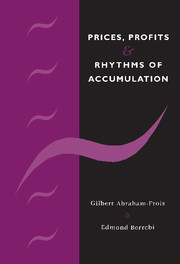Book contents
- Frontmatter
- Contents
- Preface
- 1 The golden rule of accumulation and prices
- 2 Systems of production prices
- 3 Irregular and decomposable systems
- 4 The analysis of joint production
- 5 Standards and blocking goods
- 6 Labour values and the problem of transformation
- 7 Switch in methods of production
- 8 The dynamic evolution
- Notes
- References
- Index
1 - The golden rule of accumulation and prices
Published online by Cambridge University Press: 06 July 2010
- Frontmatter
- Contents
- Preface
- 1 The golden rule of accumulation and prices
- 2 Systems of production prices
- 3 Irregular and decomposable systems
- 4 The analysis of joint production
- 5 Standards and blocking goods
- 6 Labour values and the problem of transformation
- 7 Switch in methods of production
- 8 The dynamic evolution
- Notes
- References
- Index
Summary
Within a simplified model with two goods and two activities (or methods of production), we will graphically analyse some problems related to accumulation, assuming a steady accumulation of means of production at a uniform rate g≥0 and a rate of profit r≥0 that is identical in all industries. The golden rule hypothesis, i.e., r = g, is not only convenient for drawing figures, but, as we shall see in chapter 7, it is also a sufficient condition allowing to choose efficiently among different methods of production. We will use it extensively in the following pages.
We shall start with a brief typology of the different activities. The obvious difference between ‘simple’ production and ‘joint’ production needs to be addressed within a more general context, emphasising the contrast between ‘weak’ and ‘strong’ joint production. But situations may vary with the rhythm of accumulation; which explains the notion of joint g-production, that is either weak or strong according to the situation. Through simple diagrams, we will analyse the meaning of the non-substitution theorem and the problem caused by the satisfaction of demand in the different systems we contemplate. We shall also see that the golden rule hypothesis allows to show very simply on the same diagram the evolution of relative prices with the rate of profit.
Then, we will analyse the relationship between the level of consumption (the structure of which is taken to be fixed) and the rhythm of accumulation, though it appears clearly that the relation between both variables is decreasing (which explains the use of the term ‘conflict’), the problem has to be dealt with differently according to the kind of model contemplated.
- Type
- Chapter
- Information
- Prices, Profits and Rhythms of Accumulation , pp. 1 - 38Publisher: Cambridge University PressPrint publication year: 1997
- 1
- Cited by



